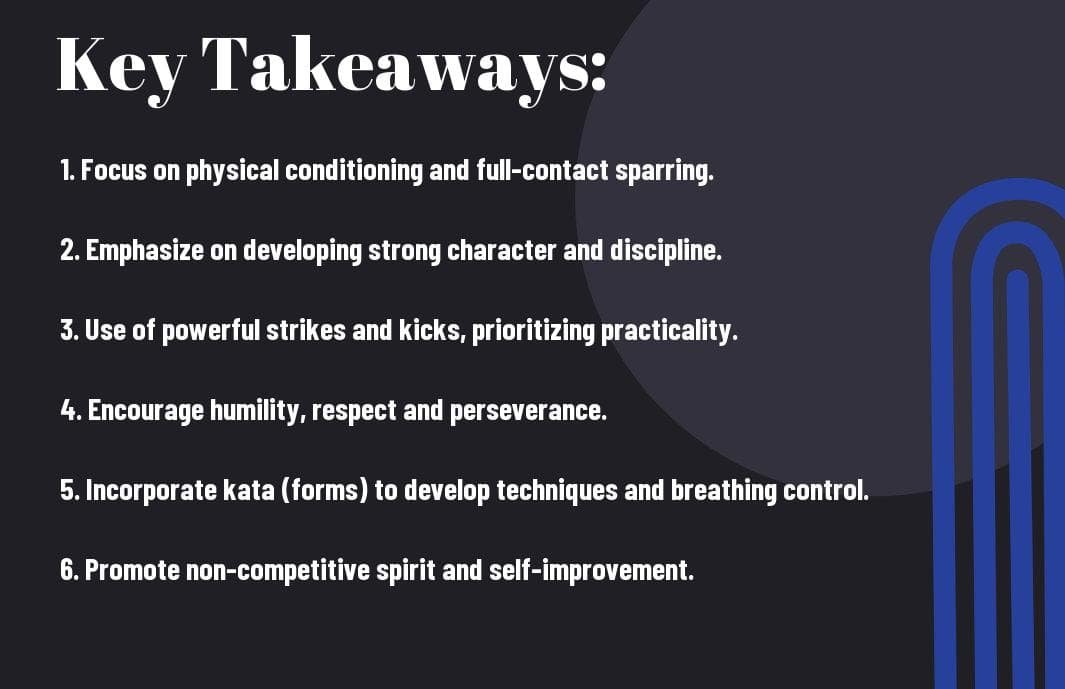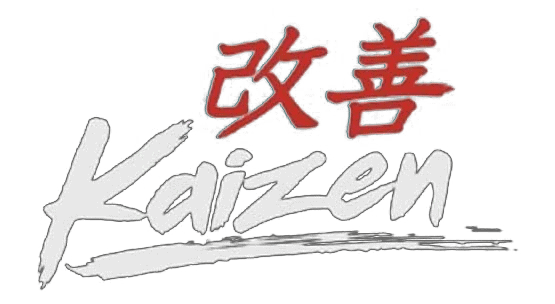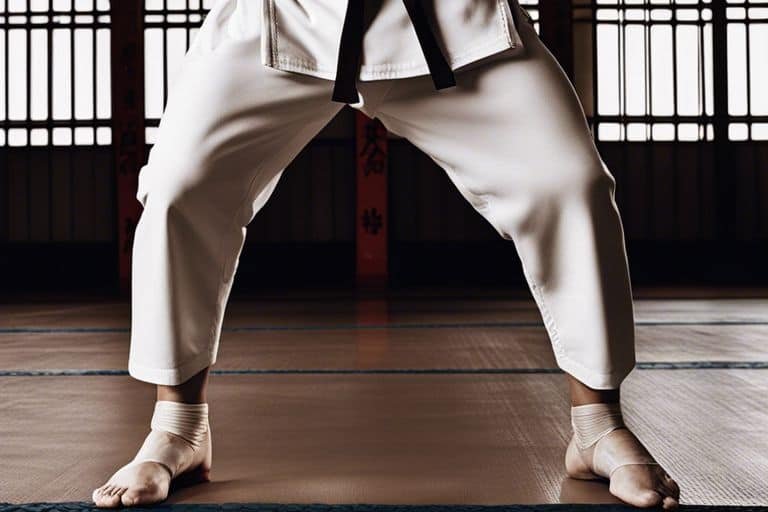Welcome to our informative blog post where you’ll discover the fundamental principles of Kyokushin Karate. If you’re seeking to deepen your understanding of this powerful martial art, it’s essential to grasp the core values that underpin its practice. By the end of this post, you will gain a comprehensive insight into the crucial principles that shape the essence of Kyokushin Karate and how they can influence your training and mindset.
Key Takeaways:
- Full-contact fighting: Kyokushin karate emphasises full-contact fighting, where participants engage in powerful strikes with their fists, elbows, knees, and feet.
- Physical toughness: Practitioners are trained to be physically tough, enduring intense conditioning exercises to build strength and resilience.
- Spiritual development: The discipline also places a strong emphasis on spiritual and mental development, promoting humility, respect, and self-control.
- Minimal use of protective gear: Unlike other forms of karate, Kyokushin practitioners typically engage in sparring with minimal protective gear, enhancing the focus on conditioning and technique.
- Practical applications: Kyokushin karate techniques are designed with practical application in mind, aiming to be effective in real-life self-defence situations.

The Philosophy of Kyokushin Karate
When you delve into the philosophy of Kyokushin Karate, you will discover a deep-rooted set of values and beliefs that form the heart and soul of this martial art. In order to fully grasp the essence of Kyokushin, it’s important to understand its underlying principles and core philosophy. If you want to learn more about the philosophy of Kyokushin Karate, you can read more about it here in our detailed write-up on the five elements of Kyokushin.
The Significance of “Kyokushin”
The term “Kyokushin” holds a significant meaning in the world of martial arts. It translates to “the ultimate truth”, and this concept forms the foundation of Kyokushin Karate. The pursuit of truth in both technique and spirit is at the core of this martial art, and it challenges you to constantly strive for excellence in your practice and personal growth.
The Dojo Kun: Guiding Principles
The Dojo Kun is a set of guiding principles that serve as a code of conduct for Kyokushin practitioners. These five maxims, including seeking perfection of character, being faithful, endeavouring, respecting others, and refraining from violent behaviour, are not only essential for your progress in Kyokushin, but they also act as a moral compass in all aspects of your life. The Dojo Kun shapes your character and cultivates a strong sense of discipline, respect, and humility, which are crucial qualities for anyone seeking to master the art of Kyokushin Karate.
“`
Technical Foundation and Training
In Kyokushin Karate, the technical foundation and training are essential components that contribute to the effectiveness and power of the martial art. The emphasis on mastering the fundamental techniques and principles is what sets Kyokushin apart and cultivates a strong, disciplined approach to training.
Stance, Movement, and Distance (Maai)
In Kyokushin Karate, your stance, movement, and understanding of distance (maai) are crucial in developing a strong foundation for your techniques. Your stance forms the basis of your stability and power, providing a solid platform for executing strikes and defensive manoeuvres. Understanding how to move efficiently and maintain the right distance from your opponent is essential for effective engagement in combat. By mastering these elements, you can control the pace and flow of the fight, giving you a significant advantage over your adversary.
Striking Techniques (Tsuki and Keri)
Your striking techniques, known as tsuki (punches) and keri (kicks), are the cornerstone of Kyokushin Karate. The focus on delivering powerful and precise strikes is what makes Kyokushin stand out among other martial arts. Your ability to execute these techniques with speed, accuracy, and force can significantly impact the outcome of a confrontation. With proper training and consistent practice, you can develop devastating striking abilities that will elevate your combat prowess. It is important to hone these skills under the guidance of experienced instructors to ensure that you are executing the techniques correctly and safely.
“`
Kyokushin Karate Forms and Sparring
In Kyokushin Karate, forms and sparring play a crucial role in the development of your skills and abilities. These aspects are essential for honing your technique, building stamina, and developing mental fortitude.
The Role of Kata in Kyokushin
Kata, or forms, are a series of predetermined movements that simulate a combat scenario against imaginary opponents. By practising kata, you can improve your balance, coordination, and concentration. Each movement has a specific purpose, and mastering these forms will enhance your understanding of techniques, as well as promote muscle memory and discipline.
Kumite: Testing Skills Through Sparring
Sparring, or kumite, is another integral part of Kyokushin Karate. It allows you to apply the techniques learned in kata in a controlled, yet realistic, environment. This not only tests your physical abilities and reflexes but also teaches you to stay calm under pressure. Kumite is an opportunity to challenge yourself and improve your fighting spirit, as well as learn the importance of strategy and adaptability in combat.
Ethics and Etiquette in Kyokushin
In Kyokushin Karate, ethics and etiquette are a crucial part of the training and philosophy. They are deeply rooted in the Japanese martial arts tradition and are essential for creating a respectful and disciplined environment in the dojo. If you want to learn more about the essential principles of Kyokushin Karate, you can refer to The Beginner’s Guide to Kyokushin Karate.
Respect and Discipline in the Dojo
Respect is one of the fundamental principles of Kyokushin Karate. In the dojo, you are expected to show respect to your instructors, fellow students, and the traditions of the art. This means bowing to your seniors, maintaining a quiet and focused attitude, and following the instructions of your instructors without question. Discipline is also highly valued in Kyokushin, and you are expected to conduct yourself with self-discipline at all times, both inside and outside the dojo. This includes showing respect to all individuals, regardless of rank or ability.
Perseverance and Integrity in Practice
Perseverance is a key aspect of Kyokushin Karate, and you will be expected to push yourself to the limit in your training. This includes enduring physical challenges, such as intense conditioning and sparring, as well as mental challenges, such as memorising and applying complex techniques. Additionally, integrity is highly valued in Kyokushin, and you are expected to be honest and ethical in all your interactions, both on and off the training mat. This includes being truthful about your abilities and accomplishments, as well as treating others with fairness and honesty.
By understanding and embodying the principles of respect, discipline, perseverance, and integrity, you will not only become a formidable martial artist but also a better person overall. These principles will guide you in your training and in your daily life, helping you to achieve success and fulfilment in all your endeavours.
Conclusion
Ultimately, the key principles of Kyokushin Karate emphasise the importance of discipline, respect, perseverance, and humility. By practicing these principles, you can not only improve your physical fitness and self-defence skills, but also cultivate a strong and disciplined character. By adhering to the values of Kyokushin Karate, you can truly embody the essence of martial arts and lead a more honourable and fulfilling life.
FAQ
Q: What are the key principles of Kyokushin Karate?
A: The key principles of Kyokushin Karate include discipline, strength, humility, respect, and self-improvement.
Q: How is Kyokushin Karate different from other styles of karate?
A: Kyokushin Karate emphasises full-contact sparring and physical conditioning, setting it apart from other traditional styles of karate.
Q: What is the significance of the term “Kyokushin”?
A: “Kyokushin” means “ultimate truth” in Japanese, reflecting the pursuit of truth and self-improvement in the practice of Kyokushin Karate.
Q: What are the main training methods used in Kyokushin Karate?
A: Main training methods in Kyokushin Karate include kihon (basics), kata (forms), and kumite (sparring), as well as physical conditioning such as body toughening exercises.
Q: What role does kata play in Kyokushin Karate?
A: Kata is a set sequence of movements that combines offensive and defensive techniques, serving as a form of moving meditation and a way to practice technique and develop focus in Kyokushin Karate.
Q: How does Kyokushin Karate promote mental and spiritual development?
A: Through rigorous training and the practice of kata, Kyokushin Karate aims to develop mental strength, discipline, and a strong spirit, fostering a sense of humility, respect, and self-control in its practitioners.
Q: What are the belt ranks in Kyokushin Karate, and how are they earned?
A: Kyokushin Karate uses a coloured belt system to signify rank, with progression based on dedication, skill, and a rigorous examination process overseen by qualified instructors.



